Cover Story
Lalon Purity vs Popularity
Although the image of a baul singing with his ektara appears intriguing, when it comes to listening to baul music, most urbanites prefer the integration of modern musical instruments in the songs. Even Lalon's music with its intense mystical elements has not been able to escape this fate. So is it more important to preserve the purity of Lalon's music or to spread his philosophy to the new generation?
Tamanna Khan
Photos: Zahedul I Khan
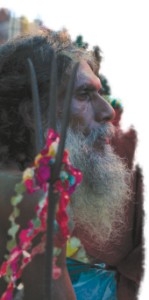 “The most amazing thing about Lalon is how a common person like him, after going through so much struggle, can rise to a transcendental stage,” says Hossain, a forty-year-old corporate official and an avid fan of Lalon's music. “The tune of Lalon's songs attracted me as a teenager. However, at that time I never understood the meaning of the words. When I went to India for my studies, I once attended a Sufi conference in Delhi, where Farida Parveen delivered Lalon's songs. There, for the first time in my life, I felt the divine aspect of his songs. The appeal of the songs broke all language barriers and brought tears to the hundreds of foreigners in the audience there,” Hossain adds. “The most amazing thing about Lalon is how a common person like him, after going through so much struggle, can rise to a transcendental stage,” says Hossain, a forty-year-old corporate official and an avid fan of Lalon's music. “The tune of Lalon's songs attracted me as a teenager. However, at that time I never understood the meaning of the words. When I went to India for my studies, I once attended a Sufi conference in Delhi, where Farida Parveen delivered Lalon's songs. There, for the first time in my life, I felt the divine aspect of his songs. The appeal of the songs broke all language barriers and brought tears to the hundreds of foreigners in the audience there,” Hossain adds.
So even 120 years after his death, Lalon's music and message have retained the power to inspire and enchant.
“The baul philosophy has reached its entirety at Lalon,” explains Dr Abul Ahsan Choudhury, an eminent Lalon researcher and professor of Bengali, Kushtia Islamic University. He says that to bauls, the teachings of the guru are like verses of holy books, which are presented sometimes through discussion and sometimes through lyrics as found in one of Lalon's songs “bhobe manush guru nistha jar, shorbo shadhon siddhya hoy tar”. However, bauls are secretive about their praying techniques and the words of the songs are often covered in riddles that only the members of the baul community understand as in Lalon's famous song Achin Pakhi which describes the human body “Aat kuthuri noi dorja ata moddhe moddhe jhalka kata tar opore sodor kotha aiyna mohol tar (The cage has eight rooms and nine closed doors; from time to time fire flares out; above there is the main room-- the mirror chamber)”.
What makes Lalon's songs special is the variation in tunes, beautiful rhythm and richness of language that at the same time is simple yet implies deeper meaning like the well-liked song “Milan hobay kotodiney amar moner manusher shone (When shall I meet my true love) ”. Although, superficially it may sound like a romantic song but the search for one's moner manush here implies the spiritual thirst for one's Creator. During Lalon's time, baul songs were mainly popular among the poor and oppressed as all the traditional religions had failed to recognise them. The baul philosophy offered simplicity based on the mysteries of creation and the creator and integrated the truth of religions like - Charyapada Buddhism, Vaishnavism and Sufism. It defies man-made division, as notable in Lalon's “Jaat gelo jaat gelo bole eki ajob karkhana, shotto kaje keu noi raji shob dekhi tananana (I'll be excommunicated, I will lose my caste cries everybody; what a strange affair is this, but no one wants to follow the path of truth; I see that everybody dillydallies).
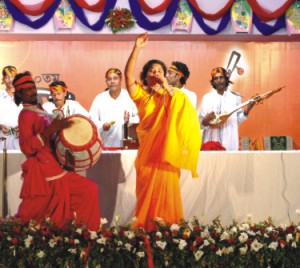 Lalon himself never talked about his religious beliefs or identified himself to any caste or religion. However he voiced strongly against the practices of institutional religions, which earned him the enmity of both Muslim and Hindu priests and thinkers of his time. In fact, in his songs, he pointed out how places of worship created a barrier between man and the Supreme, “tomar poth dhakeche mondir mosjidey; o tor dak shune shain, cholte na pai, amai rukhe darai murshide (Temple and mosque have covered your road, so O Lord! I cannot move even after hearing your call; my guru murshid has stopped me)”. Women have a special place in baul philosophy and in Lalon's songs women are given their due rights, respect and equality to an extent unthinkable even today “Pap-punner kotha ami kare ba shudhai, e deshe ja pap gonno onno deshe punno tai, Tibbot niyom onusare, ek nari bahu poti kore, ei deshete hole porey babhichaare dondo hoy (Who should I ask about sin or morality, what is sin in one country is morality in another, in Tibet one woman can have many husbands, if it happens here she will be prosecuted for adultery). Lalon himself never talked about his religious beliefs or identified himself to any caste or religion. However he voiced strongly against the practices of institutional religions, which earned him the enmity of both Muslim and Hindu priests and thinkers of his time. In fact, in his songs, he pointed out how places of worship created a barrier between man and the Supreme, “tomar poth dhakeche mondir mosjidey; o tor dak shune shain, cholte na pai, amai rukhe darai murshide (Temple and mosque have covered your road, so O Lord! I cannot move even after hearing your call; my guru murshid has stopped me)”. Women have a special place in baul philosophy and in Lalon's songs women are given their due rights, respect and equality to an extent unthinkable even today “Pap-punner kotha ami kare ba shudhai, e deshe ja pap gonno onno deshe punno tai, Tibbot niyom onusare, ek nari bahu poti kore, ei deshete hole porey babhichaare dondo hoy (Who should I ask about sin or morality, what is sin in one country is morality in another, in Tibet one woman can have many husbands, if it happens here she will be prosecuted for adultery).
According to Dr Choudhury, Lalon's songs are still very relevant in the present socio-economic and political context of the society where communalism and fundamentalism have risen to extreme levels. The secular and universal message of Lalon's songs provides inspiration and power to fight against the evils of society. However, Dr Choudhury is very much against the distortion and commercialisation of the Lalon's songs and philosophy. He particularly criticises the way Lalon's death anniversary is celebrated through a Lalon Mela that is often sponsored by corporate houses. “You can hear Hindi songs playing from the microphones and shops selling plastic goods. The phone companies are more interested to extend their business. Under the guise, Lalon gets lost,” he says.
Although Lalon himself attached little value to his social identity and endorsement, vested groups whether politicians, singers, reformers or corporate bodies have been using his name and fame for their own interest. The true spirit of Lalon's work often gets lost among the commercial and profit-seeking attitude of modern society.
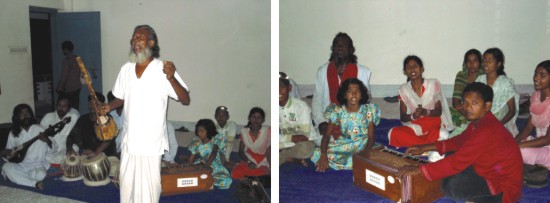
The use of modern instrument like harmonium and tabla in
baul songs has become quite common nowadays.
Farida Parveen, the venerated Lalon singer also agrees with this. “It is okay that they are sponsoring the programme, but why would they put up their logo everywhere. This demeans Shainji,” she protests. She complains that fakirs-bauls are not allowed to present their songs in the programme, even though they should have been the main focus of it. She blames the administration of the Lalon Academy for such commercialisation. “We expect that Lalon Academy should have the highest quality of instruments, the best instrumentalist and the finest singers, but this year those who sang were just jarring to the ear, lacking in rhythm and melody.”
Although Lalon songs were basically confined to the baul sects, after Independence, it reached the urban mass through established singers, who used instruments other than the ektara (one string instrument) and baya (a small drum played using the left hand). They even used classical bases for a polished presentation to appeal to the senses of the urban masses. Farida Parveen admits that the pronunciation is also refined to make the words and their meanings clearer, whereas the baul-fakirs' pronunciations are likely to have local influence.
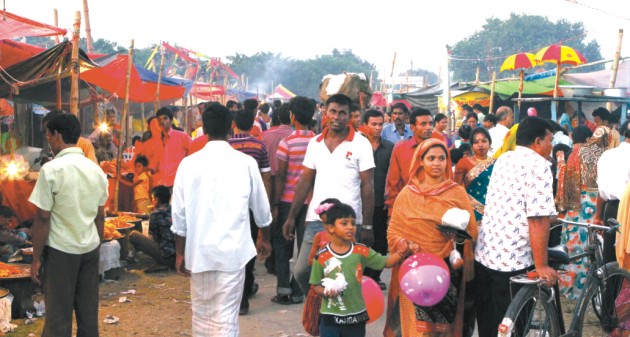
Over the years the Lalon mela has taken up a more general festive look.
However, she thinks that the use of electrical instruments removes the human elements of the music. “Music has been caged within the keyboard. The essence of the bamboo flute is no longer found. When the flutist plays the flute, he tries to bring out the tune from the pain deep inside his heart. Can you find the same feel in the tune of an electrical instrument?” asks Farida.
Nonetheless, the younger generation appreciates electrical instruments and its use in songs and thus many current artists present Lalon's songs using fusion. Sumi, the lead singer of the popular band Lalon, defends the group's use of modern instruments. She says, “My request to those who criticise us will be that instead of criticising they should try to do something positive in spreading the message of Lalon to the younger generation.”
 |
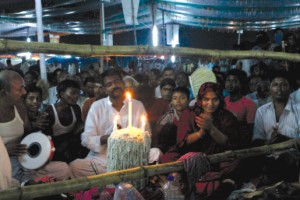 |
Although some shops adjacent to Lalon Academy sell local goods, many others display items brought from Dhaka. |
For many Lalon is a mystic; a visit to his
mausoleum offers solace to the
devotee. |
Unfortunately, the role of the Lalon Academy in protecting and promoting Lalon's songs, initiating Lalon research and developing trained Lalon- geeti singers has been zero according to Farida Parveen's opinion. However at individual levels, researchers like Dr Choudhury are trying to collect authentic lyrics and music by Lalon while many others like Farida Parveen are trying to document the notations to protect the original tunes.
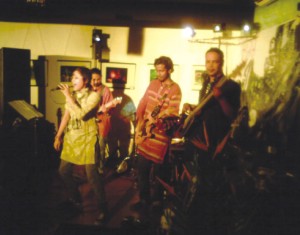 |
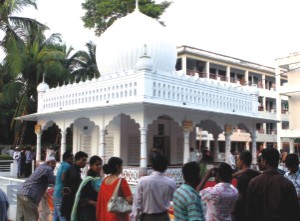 |
The band “Lalon” has become popular among the young generation
for their different style of presenting Lalon's songs. |
|
About fusion, music enthusiasts like Hossain says, “You will see this (fusion) is not likely to last long. It is a fad and will disappear with time. Rather it is the raw form of the songs that will remain through ages.” Lalon's message and philosophy, rising above all our narrow-mindedness and the need for constant gratification through the material and commercial, will continue to thrive among the common people of Bengal, who had originally embraced Lalon in the face of oppression and social deprivation.
Most of the translations of Lalon's songs have been taken from Abul Ahsan Choudhury's book “Lalon Shain-er Shondhaney”.
Life of a Mystic
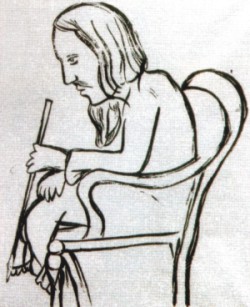 |
Sketch of Lalon Shain by Jyotirindranath Tagore, elder brother of Rabindranath Tagore, who drew this on May 5, 1889, having him sit on a boat in Shilaidaha. |
Lalon Shain also known as Lalon Shah or Lalon Fakir, revered among the bauls (mystic musicians of Bengal) as a saint, has been the centre of inspiration, inquisitiveness and awe among common people as well as modern day philosophers and researchers. Through his songs, this reclusive, village philosopher had left messages of social reform and religious harmony at a time when such bold statements in beautifully knitted words were unexpected from a village-born uneducated commoner. Questions about Lalon, his life and work, are many and much of it has remained unanswered.
As Lalon himself remained silent about his past, the early life of Lalon Shain is shrouded in mystery. Yet based on newspapers and essays of his time, a rough picture of Lalon's life is drawn by present day researchers. It is assumed that Lalon was born in 1774 in Bharara, a village by the Gorai River in Kushtia to a poor Hindu low-caste family. From a young age, he was attracted to folksongs like kirtan, kabigaan and religious thoughts. Having lost his father at a young age, he took up the responsibilities of the family, but a dispute with his relatives made him shift to a different neighbourhood after marriage.
During this time, it is believed that he went on a pilgrimage with a couple of bauls from his neighbourhood. On his return, he contracted smallpox; his fellow travellers, fearing his death, after a quick funeral threw his body in the river. His unconscious body was rescued by a Muslim woman, who helped him recover from the disease that left permanent marks in his face and cost him an eye. He then tried to go back home but community heads of his village and his relatives refused to accept him as his final rites were completed and he had taken food in the house of a Muslim.
This incident developed contempt about institutional religions and their rituals in Lalon's mind and he decided to renounce material life. In his search for the true meaning of life, he became the disciple of baul guru Siraj Shain and thus began his spiritual journey. With his guru's blessings, he set up his own akhra (the abode of baul community) at Cheuria, Kustia on 1823 and began to preach secular and non-conformist thoughts among the deprived people of the villages. He had spent his entire life there and in the morning of October 17, 1890, this centenarian mystic musician, while singing “paar koro doyalchand amare, khomo he oporadh amar bhobokaragare (Help me cross O Lord! Forgive me for my wrongdoings in this world)” breathed his last.
Are we Losing the Real Lalon?
Elita Karim
Photos: Zahedul I Khan
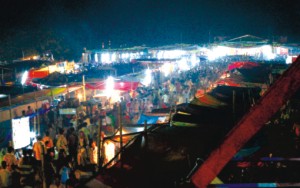 |
The colourful evenings of Lalon Mela. |
Every year, Lalon Shain's death anniversary is marked with a mela or a daylong fair, where a spiritual ambience is created through music and the age-old words of Lalon and his followers. This year, the mela began on October 16 and went on for five days. Every year, thousands of people and admirers of Lalon Shain get together to remember him and spread his message of love and humanity to everyone.
The five-day-long fair saw a huge number of people from all over the country paying homage to Lalon Shain at his shrine. Sponsored by Banglalink, it has been just a few years that the mela has been running for three days or more. “Earlier, it was only a day of observation when people from all over would come to the mazaar to pay their respects to Shainji,” says Nur Alam, a resident of Kushtia and also one of the stall owners at the fair. Alam is seen selling Tshirts, dresses, three pieces and other assortments like playing cards and plastic flowers in his stall. Like Alam, a large number of stall owners, this year, proudly showcase their wares and items for the visitors which may seem a little anomalous for purists who condemn what they consider the commercialisation of a spiritual commemoration.
The days were filled with shadhus, baul singers, followers of Lalon Shain and visitors from all over, filling up every bit of available space to rest or talk. The evenings would be filled with music, colours, lights and even dances. Several musicians and singers from outside Kushtia were also seen enjoying the fair and listening awestruck to the impromptu compositions of the bauls and shadhus. Like clockwork, groups of people entered the long, white doorway to Lalon's mazaar, paying homage to him and then walking back to enjoy the fair. The group then moved from stall to stall, enjoying a ride in the nagordola and a quick bite of the snacks and meals readily available on the streets. “This is my third time at the mela,” says Shakil Reza Haque, a businessperson from Dhaka. “Every year the fair seems to get bigger and more vibrant with people and colour. I just hope that the actual purpose of the mela eventually does not get lost amidst all the glamour that is being made a part of the Lalon mela.”
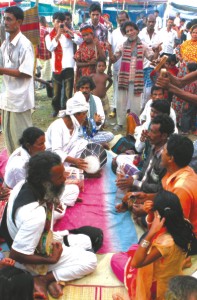 The local bauls and shadhus, who have created a name for themselves over the years, got together on the first two days to spread their messages. In fact, the second day of the mela was all the more vibrant and colourful as it was the last day of the Durga Puja, which was celebrated on the same day. The local bauls and shadhus, who have created a name for themselves over the years, got together on the first two days to spread their messages. In fact, the second day of the mela was all the more vibrant and colourful as it was the last day of the Durga Puja, which was celebrated on the same day.
One of the main attractions at the fair was the discussion sessions and the music shows which would start in the evening and sometimes go on till the early hours the next morning. Heart-wrenching lyrics and the spiritual music would build a sacred ambience for hours together which held the crowd captivated throughout the night. The singers, through their songs, spoke about love, people and divinity.
In spite of the fact that the Lalon mela attracts a huge number of visitors every year, some expected much more from the five-day-long fair. “This was my first time at the mela,” says Adil Hossain, a filmmaker from Dhaka. “And I felt that I didn't see the purpose being fulfilled, that is, paying homage to the great Lalon Shain. Other than the few shops that were selling traditional instruments used by the baul musicians, most of the stalls had clothes and items probably brought in from Dhaka. Besides that, I could hear the song 'Munni Badnam hui, darling tere liye', which was being played in the loud speakers the whole time. It is a famous Indian 'item number' and I seriously did not expect to hear this song at the Lalon Mela.”
Many say that the Lalon Mela is slowly turning into yet another commercial event, where people will eventually forget the fact that this event is organised to pay tribute to Lalon Shain himself. The only way to keep it real and spiritual is if the Government steps up and decides to take the mela under its wings.
opyright
(R) thedailystar.net 2010 |
| |
